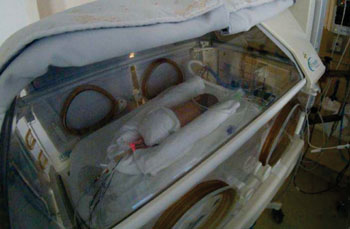Blocking Light Improves Premature Babies Survival
By HospiMedica International staff writers
Posted on 06 Oct 2015
The survival rate of premature neonates born between 26-31 weeks of gestation is improved by blocking light from reaching the parenteral nutrition (PN) feed line, according to a new study.Posted on 06 Oct 2015
Researchers at Sainte-Justine University Hospital Center (Montreal, Canada), the University of Montreal (Canada), and the University of Mansoura (Egypt), as well as other institutions, conducted a meta-analysis of clinical trials and observational studies that investigated the effect of light-exposure on PN to determine whether photoprotection reduces neonatal mortality in preterm infants.

Image: Premature baby receiving parenteral nutrition (Photo courtesy of the University of Montreal).
In all, four trials met the selection criteria, which involved a total of 800 newborn premature infants. Across trials, gestational age ranged from a mean 26 to 31 weeks, birth weight from a mean 775 to 1,588 grams, and mortality from 5% to 32%. Mortality in the light-protected group was half of that in the light-exposed group and twice as high in males compared with females, probably due to a lower resistance to oxidative stress. The study was published on September 16, 2015, in the Journal of Parenteral and Enteral Nutrition.
“The photo-excited vitamins B2 and 'electron donors' such as vitamin C, amino acids, and lipids all interact in the multivitamin solution and generate oxidants,” said lead author Jean-Claude Lavoie, PhD. “This creates an oxidative stress which damages and kills newborn cells. Fortunately, studies show that shielding parenteral nutrition from light significantly decreases such an interaction. An easy to implement fully light-shielded delivery system for parenteral nutrition needs to be developed to reduce mortality rates in premature infants.”
“The solution has to be shielded from the moment it is prepared in the pharmacy all the way through to infusion on the ward, including all bags, tubing and syringes through which it passes,” specified study coauthor Maxime Thibault, BPharm, MSc, a pharmacist at CHU Sainte-Justine. “Partial photo-protection is ineffective in preventing oxidant generation.”
Parenteral nutrition is essential to the survival of preterm babies because it provides them with vital nutrients such as proteins, fat, and glucose, enabling them to develop as fetuses of their age would do in their mother's womb. But this type of food preparation, when exposed to light, generates oxidants which the premature infant's immature defenses cannot fight.
Related Links:
Sainte-Justine University Hospital Center
University of Montreal
University of Mansoura














